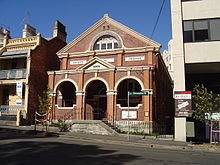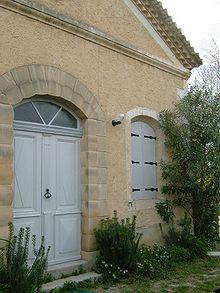- Friends meeting house
-
Chichester Friends Meeting House near Philadelphia, built 1769

A Friends meeting house is a meeting house of the Religious Society of Friends (Quakers), where meeting for worship may be held.
Contents
History
Quakers do not believe that meeting for worship should take place in any special place. They believe that "where two or three meet together in my name, I am there among them" (Revised English Bible, Matthew, Ch 18, v 20). Therefore meeting for worship may take place in any place. Early Quakers often met for worship outdoors or in local public buildings. However, when the Religious Society of Friends began to grow there became a need for buildings to house their meetings.
Quakers have always reserved the word church to mean the body of people who make up the worshiping community: Quakers do not use the word church to refer to the bricks and mortar of a worshiping community. George Fox, an early Quaker, spoke of places of worship that have steeples as steeple houses, and those that do not as meeting houses. This practice is shared by a number of other non-conformist Christian denominations, including Unitarians, Christadelphians, the Church of Jesus Christ of Latter-day Saints and Mennonites.
Some Friends meeting houses were adapted from existing structures, but most were purpose-built. Briggflatts Meeting House is an example of the latter. The hallmark of a meeting house is extreme simplicity and the absence of any liturgical symbols. More specifically, though, the defining characteristics of the Quaker meetinghouse are simplicity, equality, community, and peace. Though never explicitly written or spoken about, these tenets (or “Testimonies”) of Quakerism were the basic, and only, guidelines for building a meetinghouse, as was seen through the continuity of the use of Testimonies within meetinghouse design. While meetinghouse design evolved over time to a standardization of the double-cell structure without explicit guidelines for building, the meetinghouse’s reflective architecture revealed a deeper meaning. The meetinghouse design manifested and enhanced Quaker Testimonies and the cultivation of the Inner Light that was essential to Friends. Quakers easily moved from one place of meeting to another, but when given the opportunity to design and construct their own place of meeting, Friends infused their Testimonies in the planning, design, and construction of the building.
 Sydney Friends meeting house
Sydney Friends meeting house
Meeting Houses built in a traditional style usually had two meeting rooms: one for the main meeting for worship, and another where the women's business meeting may be held (often referred to as the women's meeting room). Meeting houses of this style usually have a minister's gallery at one end of the meeting room, where traditionally those traveling in the ministry would have sat, with an elders bench immediately in front of this. Wooden benches facing this occupy the rest of the room, often with a gallery for extra seating. Meeting houses of this style usually have high windows so that worshippers sitting in meeting for worship cannot see outside.
Meeting houses built in a more modern design will usually consist of: a large meeting room, smaller rooms for committees, children's classes, etc., a kitchen and toilets.
The meeting room itself is a place for Friends to withdraw from the world. The windows are set sufficiently high that worshippers will not be distracted by the activities of the world's people outside, or in some cases they provide a view into the meeting house garden. The seating was originally long, hard and wooden. Today it is usually separate chairs but the layout remains the same — a square or rectangle facing inwards to a central table.
Examples
The Quaker Meeting House in Congénies
United Kingdom
- Briggflatts Meeting House, Cumbria
- Jordans Friends Meeting House, Buckinghamshire
- Leicester Friends Meeting House
- Osmotherley Friends Meeting House, North Yorkshire
France
- The historic meeting house of Congénies since 1788
United States
- Abington Friends Meeting House
- Amesbury Friends Meeting House
- Arch Street Friends Meeting House, Philadelphia, Pennsylvania
- Benjaminville Friends Meeting House
- Cornwall Friends Meeting House
- Frankford Friends Meeting House, Philadelphia, Pennsylvania
- Friends Meetinghouse (Jamestown, Rhode Island)
- Friends Meetinghouse (Uxbridge, Massachusetts)
- Friends Meeting House and Cemetery, Little Compton, Rhode Island
- Great Friends Meeting House
- Oblong Friends Meeting House
- Nine Partners Meeting House and Cemetery, Millbrook, New York
- Portsmouth Friends Meetinghouse Parsonage and Cemetery
- Race Street Friends Meetinghouse, Philadelphia, Pennsylvania
- Sandy Spring Friends Meetinghouse
- Smith Clove Meetinghouse, Highland Mills, NY
- Smithfield Friends Meeting House, Parsonage & Cemetery
- South River Friends Meetinghouse, Lynchburg, Virginia
- Third Haven Meeting House
- Upper Dublin Friends Meeting House
- Yardley Friends Meeting House, Yardley, Pennsylvania
External links
- Flickr site for photographs of British Friends Meeting Houses, arranged by County
- Randolph Friends Meeting House
- Friends meeting houses UK search
Religious Society of Friends Quakers List of Quakers · Anthony Benezet · Kenneth E. Boulding · Margaret Fell · George Fox · Elizabeth Fry · Edward Hicks · Elias Hicks · Rufus Jones · Lucretia Mott · William Penn · Robert Pleasants · John Greenleaf Whittier · John Woolman
Groups Testimonies Peace · Equality · Integrity · Simplicity
Other Businesses, organizations and charities · Clerk · History · Homosexuality · Inner light · Meeting houses · Query · Schools · Tapestry · Wedding · Women
Categories:- Quakerism
- Religious buildings
- Types of church buildings
Wikimedia Foundation. 2010.



